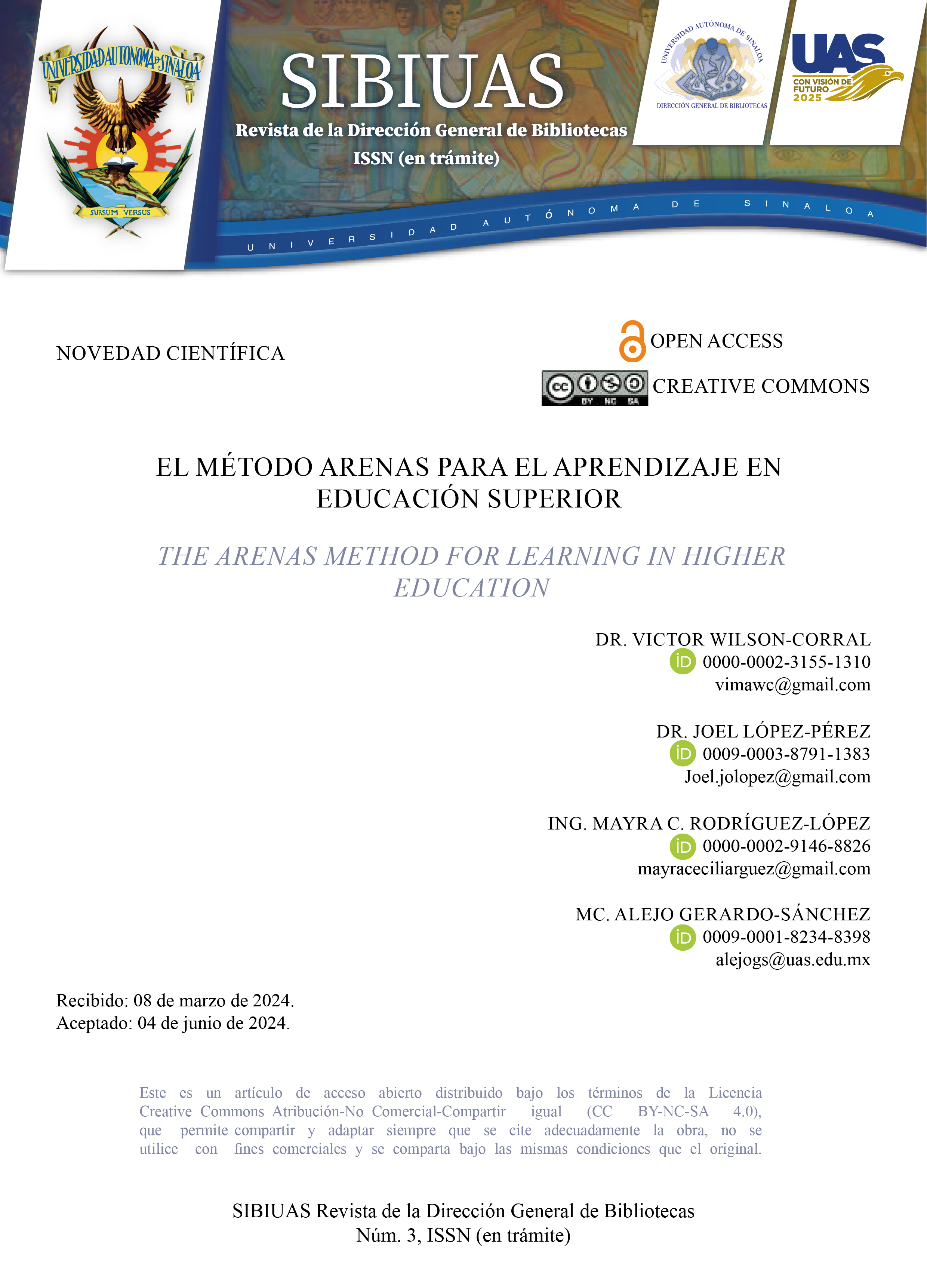The Arenas Method for learning in Higher Education
Keywords:
Learning paradigm, Motivation, Arenas MethodAbstract
Learning should not be a difficult task when individuals are motivated by subjects that interest them. Motivation plays a crucial role in this process. The minimum necessary technological resources, which seems to be available, become very useful tools to facilitate learning. The traditional educational model, based on the teaching paradigm, has been questioned for decades. As a result, innovative educational approaches based on the learning paradigm are gaining increasing attention in educational communities. One such method is the Arenas Method (AM), which is being implemented in some educational institutions. This method has proven to produce professionals of highly satisfactory quality standards. This article explores the importance of motivation in the learning process and the impact of innovative educational approaches, such as the Arenas Method, in the formation of highly skilled professionals.
Downloads
References
Abachi, H. R., and Muhammad, G. (2014). The impact of m-learning technology on students and educators. Computers in Human Behavior, 30, 491-496.
Anderson, C. W. N. (2008). Congratulations. July 08. Surutato, pp. 1-1.
Azamar-Alonso, A. (2015). El modelo educativo en México: una revisión de su alcance y una perspectiva para el futuro. Rastros Rostros 17(31), 127-141.
Barr, R., and Tagg, J. (1995). From Teaching to Learning. A new paradigm for undergraduate education. Change, 27, 12-25.
Bundy, A. (2003). El marco para la alfabetización informacional en Australia y Nueva Zelanda: principios, normas y práctica. Boletín de la Asociación Andaluza de Bibliotecarios (73), 109-120.
Cereijido, M. (2009). El analfabetismo científico del primer mundo, In: La ciencia como calamidad: Un ensayo sobre el analfabetismo científico y sus efectos. Barcelona. Gedisa. pp. 131-153.
Clarivate. (2023). Journal Citation Report. USA. 131 pp.
DiResta, R. (2019). Of virality and viruses: the anti-vaccine movement and social media, T. f. g. security, (ed.) NAPSNet Special Reports. City: Institute for Security and Technology. Accessed January 07. Available at: Of Virality and Viruses: The Anti-Vaccine Movement and Social Media | by Institute for Security and Technology | Medium.
Duarte-García, E. (2007). Gestores personales de bases de datos de referencias bibliográficas: características y estudio comparativo. El profesional de la información, 16(6), 647-656.
Espinosa Freire, E. E. (2018). La hipótesis en la investigación. Mendive: Revista de Educación, 16(1), 122-139.
Fundación Española para la Ciencia y la Tecnología (FECYT). (2023). Guía de evaluación. Octava edición del procedimiento para la participación en la evaluación de la calidad editorial y científica de revista científicas españolas. 20 pp. Disponible en: VIII Convocatoria (2022) | Calidad revistas (fecyt.es)
Garfield, E. (1987). English Spoken Here. The Scientist, 1(20), 9.
Jimenez, J. (2009). New Collaborative Forms of Doing Research, in Denis, A. and Kalekin- Fishman, D., (ed.), The ISA handbook in contemporary sociology. London, pp. 91-105.
Jimenez, J., and Velazco, M. N. (2016). Alternative Learning and Research Leading to Development. Athens Journal of Social Sciences, 3(2), 113-125.
Licea de Arenas, J. (2007). La evaluación de la alfabetización informacional: principios, metodologías y retos. Anales de Documentación, 10, 215-232.
Licea de Arenas, J. (2009). La alfabetización informacional en el entorno hispanoamericano. Anales de Documentación (12), 93-106.
López-Cózar, E. D., Ruiz-Pérez, R., and Jiménez-Contreras, E. (2007). La Edición de Revistas Científicas Directrices, Criterios y Modelos de Evaluación, Granada: FECYT. 263 pp.
López-Pérez, J., and Juárez-López, F. S. (2012). El Método Arenas: Aplicación del PbL para la formación de científicos en países con economías en desarrollo, Bloomington: Palibrio. 269 pp.
Navas, M. (2017). La situación de las revistas a nivel internacional, in E. Abadal, (ed.), Situación actual y retos de futuro. Barcelona: Universidad de Barcelona, pp. 35-51.
Phillips, E. M., and Pugh, D. S. (1996). How to get a PhD (Second Edition) Buckingham: University Press. 203 pp.
ULRICHS. (2024). Serials Analysis System. ULRICHS, Available at: https://ulrichsweb.serialssolutions.com/login.
Ware, M., and Mabe, M. (2015). The STM Report: An overview of scientific and scholarly journal publishing: International Association of Scientific. Netherlands. 180 pp.
Warner, D. A. (2003). Programmatic Assessment: Turning process into practice by teaching for learning. Journal of Academic Librarianship 29, 169-176.
Wilson-Corral, V. (2023). Las hipótesis en la investigación científica. SIBIUAS, 1(1,), 45- 49.
Wilson-Corral, V., Rodríguez-López, M., Jiménez Guzmán, J., and Nieves Soto, M. (2013). El uso inteligente de herramientas de búsqueda en ciencia, aplicado a la sismicidad en minas Estudio de caso. Perfiles Educativos, XXXV (141), 115-130.
Xie, H., Chu, H.-C., Hwang, G.-J., and Wang, C.-C. (2019). Trends and development in technology-enhanced adaptive/personalized learning: A systematic review of journal publications from 2007 to 2017. Computers & Education, 140, 103599.

Downloads
Published
Issue
Section
Categories
License
Copyright (c) 2024 SIBIUAS Revista de la Dirección General de Bibliotecas

This work is licensed under a Creative Commons Attribution-NoDerivatives 4.0 International License.

